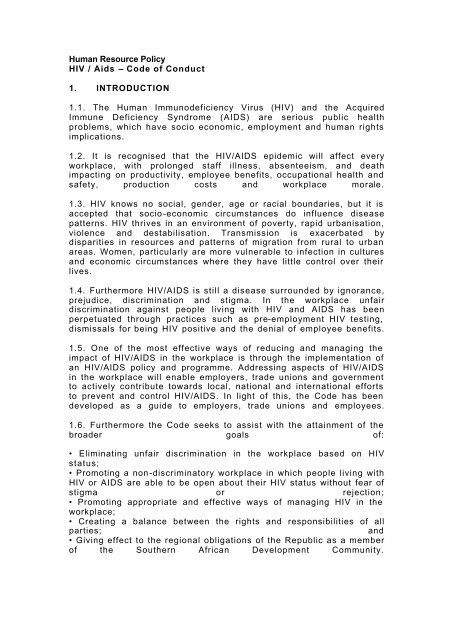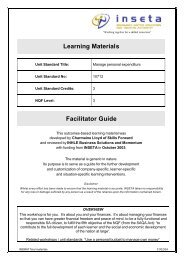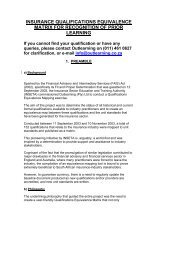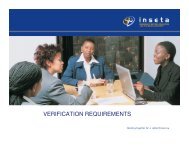Human Resource Policy HIV / Aids â Code of Conduct 1 ... - Inseta
Human Resource Policy HIV / Aids â Code of Conduct 1 ... - Inseta
Human Resource Policy HIV / Aids â Code of Conduct 1 ... - Inseta
Create successful ePaper yourself
Turn your PDF publications into a flip-book with our unique Google optimized e-Paper software.
5.3.10. In accordance with both the common law and Section 14 <strong>of</strong> theConstitution <strong>of</strong> South Africa Act, No. 108 <strong>of</strong> 1996, all persons with <strong>HIV</strong>or AIDS have a right to privacy, including privacy concerning their <strong>HIV</strong>or AIDS status. Accordingly there is no general legal duty on anemployee to disclose his or her <strong>HIV</strong> status to their employer or tootheremployees.6. PROMOTING A NON-DISCRIMINATORY WORK ENVIRONMENT6.1. No person with <strong>HIV</strong> or AIDS shall be unfairly discriminated againstwithin the employment relationship or within any employment policiesor practices, including with regard to:(i) recruitment procedures, advertising and selection criteria;(ii) appointments, and the appointment process, including jobplacement;(iii) job classification or grading;(iv) remuneration, employment benefits and terms and conditions <strong>of</strong>employment;(v) employee assistance programmes;(vi) job assignments;(vii).the workplace and facilities;(viii).occupational health and safety;(ix) training and development;(x) performance evaluation systems;(xi) promotion, transfer and demotion;(xii) disciplinary measures short <strong>of</strong> dismissal; and(xiii) termination <strong>of</strong> services.6.2.To promote a non-discriminatory work environment based on theprinciple <strong>of</strong> equality, employers and trade unions should adoptappropriate measures to ensure that employees with <strong>HIV</strong> and AIDS arenot unfairly discriminated against and are protected from victimisationthrough positive measures such as:(i) preventing unfair discrimination and stigmatisation <strong>of</strong> people livingwith <strong>HIV</strong> or AIDS through the development <strong>of</strong> <strong>HIV</strong>/AIDS policies andprogrammes for the workplace;(ii) awareness, education and training on the rights <strong>of</strong> all persons withregard to <strong>HIV</strong> and AIDS;(iii) mechanisms to promote acceptance and openness around<strong>HIV</strong>/AIDS in the workplace;(iv) providing support for all employees infected or affected by <strong>HIV</strong> andAIDS;and(v) grievance procedures and disciplinary measures to deal with <strong>HIV</strong>relatedcomplaints in the workplace.7. <strong>HIV</strong> Testing, Confidentiality and disclosure7.1. <strong>HIV</strong> Testing7.1.1. No employer may require an employee, or an applicant foremployment, to undertake an <strong>HIV</strong> test in order to ascertain thatemployee’s <strong>HIV</strong> status. As provided for in the Employment Equity Act,employers may approach the Labour Court to obtain authorisation for
testing.7.1.2. Whether s 7(2) <strong>of</strong> the Employment Equity Act prevents IBSprovidedhealth service supplying a test to an employee who requestsa test, depends on whether the Labour Courts would accept that anemployee can knowingly agree to waive the protection in the section.This issue has not yet been decided by the courts.7.1.3. In implementing the sections below, it is recommended thatparties take note <strong>of</strong> the position set out in item 7.1.2.7.1.4. Authorised testingEmployers must approach the Labour Court for authorisation in,amongst others, the following circumstances:(i) during an application for employment;(ii) as a condition <strong>of</strong> employment;(iii) during procedures related to termination <strong>of</strong> employment;(iv) as an eligibility requirement for training or staff developmentprogrammes;and(v) as an access requirement to obtain employee benefits.7.1.5. Permissable testing(a) IBS may provide testing to an employee who has requested a testin the following circumstances:(i) As part <strong>of</strong> a health care service provided in the workplace;(ii) In the event <strong>of</strong> an occupational accident carrying a risk <strong>of</strong> exposureto blood or other body fluids;(iii) For the purposes <strong>of</strong> applying for compensation following anoccupational accident involving a risk <strong>of</strong> exposure to blood or otherbodyfluids.(b)Furthermore, such testing may only take place within the followingdefinedconditions:i. At the initiative <strong>of</strong> an employee;ii. Within a health care worker and employee-patient relationship;iii. With informed consent and pre- and post-test counselling, asdefined by the Department <strong>of</strong> Health’s National <strong>Policy</strong> on Testing for<strong>HIV</strong>;andiv. With strict procedures relating to confidentiality <strong>of</strong> an employee’s<strong>HIV</strong> status as described in clause 7.2 <strong>of</strong> this <strong>Code</strong>.7.1.6 All testing, including both authorised and permissible testing,should be conducted in accordance with the Department <strong>of</strong> Health’sNational <strong>Policy</strong> on Testing for <strong>HIV</strong> issued in terms <strong>of</strong> the National<strong>Policy</strong> for Health Act, No. 116 <strong>of</strong> 1990.7.1.7 Informed consent means that the individual has been providedwith information, understands it and based on this has agreed toundertake the <strong>HIV</strong> test. It implies that the individual understands whatthe test is, why it is necessary, the benefits, risks, alternatives andany possible social implications <strong>of</strong> the outcome.
7.1.8 Anonymous, unlinked surveillance or epidemiological <strong>HIV</strong> testingin the workplace may occur provided it is undertaken in accordancewith ethical and legal principles regarding such research. Where suchresearch is done, the information obtained may not be used to unfairlydiscriminate against individuals or groups <strong>of</strong> persons. Testing will notbe considered anonymous if there is a reasonable possibility that aperson’s <strong>HIV</strong> status can be deduced from the results.7.2. Confidentiality and Disclosure7.2.1. All persons with <strong>HIV</strong> or AIDS have the legal right to privacy. Anemployee is therefore not legally required to disclose his or her <strong>HIV</strong>status to their employer or to other employees.7.2.2. Where an employee chooses to voluntarily disclose his or her<strong>HIV</strong> status to the employer or to other employees, this information maynot be disclosed to others without the employee’s express writtenconsent. Where written consent is not possible, steps must be taken toconfirm that the employee wishes to disclose his or her status.7.2.3. Mechanisms should be created to encourage openness,acceptance and support for those employers and employees whovoluntarily disclose their <strong>HIV</strong> status within the workplace, including:(i) encouraging persons openly living with <strong>HIV</strong> or AIDS to conduct orparticipate in education, prevention and awareness programmes;(ii) encouraging the development <strong>of</strong> support groups for employeesliving with <strong>HIV</strong> or AIDS; and(iii) ensuring that persons who are open about their <strong>HIV</strong> or AIDS statusare not unfairly discriminated against or stigmatised.8. Promoting safe workplace1. IBS is obliged to provide and maintain, as far as is reasonablypracticable, a workplace that is safe and without risk to the health <strong>of</strong>itsemployees.2. The risk <strong>of</strong> <strong>HIV</strong> transmission in the workplace is minimal. Howeveroccupational accidents involving bodily fluids may occur, particularly inthe health care pr<strong>of</strong>essions. Every workplace should ensure that itcomplies with the provisions <strong>of</strong> the Occupational Health and SafetyAct, including the Regulations on Hazardous Biological Agents, andthe Mine Health and Safety Act, and that its policy deals with, amongstothers :i. the risk, if any, <strong>of</strong> occupational transmission within the particularworkplace;ii. appropriate training, awareness, education on the use <strong>of</strong> universalinfection control measures so as to identify, deal with and reduce therisk <strong>of</strong> <strong>HIV</strong> transmission in the workplace;iii. providing appropriate equipment and materials to protectemployees from the risk <strong>of</strong> exposure to <strong>HIV</strong>;iv. the steps that must be taken following an occupational accidentincluding the appropriate management <strong>of</strong> occupational exposure to <strong>HIV</strong>and other blood borne pathogens, including access to post-exposure
prophylaxis;v. the procedures to be followed in applying for compensation foroccupationalinfection;vi the reporting <strong>of</strong> all occupational accidents; andvii. adequate monitoring <strong>of</strong> occupational exposure to <strong>HIV</strong> to ensurethat the requirements <strong>of</strong> possible compensation claims are being met.9. Compensation for occupationally acquired <strong>HIV</strong>9.1. An employee may be compensated if he or she becomes infectedwith <strong>HIV</strong> as a result <strong>of</strong> an occupational accident, in terms <strong>of</strong> theCompensation for Occupational Injuries and Diseases Act.9.2. Employers should take reasonable steps to assist employees withthe application for benefits including:(i) providing information to affected employees on the procedures thatwill need to be followed in order to qualify for a compensation claim;and(ii) assisting with the collection <strong>of</strong> information which will assist withproving that the employees were occupationally exposed to <strong>HIV</strong>infectedblood.9.3. Occupational exposure should be dealt with in terms <strong>of</strong> theCompensation for Occupational Injuries and Diseases Act. Employersshould ensure that they comply with the provisions <strong>of</strong> this Act and anyprocedure or guideline issued in terms there<strong>of</strong>.10. Employee benefits10.1. Employees with <strong>HIV</strong> or AIDS may not be unfairly discriminatedagainst in the allocation <strong>of</strong> employee benefits.10.2. Employees who become ill with AIDS should be treated like anyother employee with a comparable life threatening illness with regardto access to employee benefits.10.3. Information from benefit schemes on the medical status <strong>of</strong> anemployee should be kept confidential and should not be used tounfairlydiscriminate.10.4. Where IBS <strong>of</strong>fers a medical scheme as part <strong>of</strong> the employeebenefit package it must ensure that this scheme does not unfairlydiscriminate, directly or indirectly, against any person on the basis <strong>of</strong>his or her <strong>HIV</strong> status.11. Dismissal11.1. Employees with <strong>HIV</strong>/AIDS may not be dismissed solely on thebasis <strong>of</strong> their <strong>HIV</strong>/AIDS status.11.2. Where an employee has become too ill to perform their currentwork, IBS is obliged to follow accepted guidelines regarding dismissalfor incapacity before terminating an employee’s services, as set out inthe <strong>Code</strong> <strong>of</strong> Good Practice on Dismissal contained in Schedule 8 <strong>of</strong> theLabour Relations Act.11.3. The employer should ensure that as far as possible, the
employee’s right to confidentiality regarding his or her <strong>HIV</strong> status ismaintained during any incapacity proceedings. An employee cannot becompelled to undergo an <strong>HIV</strong> test or to disclose his or her <strong>HIV</strong> statusas part <strong>of</strong> such proceedings unless the Labour Court authorised such atest.12. Grievance procedures12.1. Employers should ensure that the rights <strong>of</strong> employees withregard to <strong>HIV</strong>/AIDS, and the remedies available to them in the event <strong>of</strong>a breach <strong>of</strong> such rights, become integrated into existing grievanceprocedures.12.2. Employers should create an awareness and understanding <strong>of</strong> thegrievance procedures and how employees can utilise them.12.3. Employers should develop special measures to ensure theconfidentiality <strong>of</strong> the complainant during such proceedings, includingensuring that such proceedings are held in private.13. Management <strong>of</strong> <strong>HIV</strong> in the workplace13.1. The effective management <strong>of</strong> <strong>HIV</strong>/AIDS in the workplace requiresan integrated strategy that includes, amongst others, the followingelements:13.1.1. An understanding and assessment <strong>of</strong> the impact <strong>of</strong> <strong>HIV</strong>/AIDSon the workplace; and13.1.2. Long and short term measures to deal with and reduce thisimpact14. Assessing the impact <strong>of</strong> <strong>HIV</strong>/AIDS on the workplace14.1.1. Employers and trade unions should develop appropriatestrategies to understand, assess and respond to the impact <strong>of</strong><strong>HIV</strong>/AIDS in their particular workplace and sector. This should be donein cooperation with sectoral, local, provincial and national initiatives bygovernment, civil society and non-governmental organisations.14.1.2. Broadly, impact assessments should include:(i) Risk pr<strong>of</strong>iles; and(ii) Assessment <strong>of</strong> the direct and indirect costs <strong>of</strong> <strong>HIV</strong>/AIDS;14.3. Risk pr<strong>of</strong>iles may include an assessment <strong>of</strong> the following:i. The vulnerability <strong>of</strong> individual employees or categories <strong>of</strong> employeesto <strong>HIV</strong> infection;ii. The nature and operations <strong>of</strong> the organisation and how these mayincrease susceptibility to <strong>HIV</strong> infection (eg migrancy or hosteldwellings);iii. A pr<strong>of</strong>ile <strong>of</strong> the communities from which the organisation draws itsemployees;iv. A pr<strong>of</strong>ile <strong>of</strong> the communities surrounding the organisation’s place <strong>of</strong>
operation;andv. An assessment <strong>of</strong> the impact <strong>of</strong> <strong>HIV</strong>/AIDS upon their target marketsand client base.14.4. The assessments should also consider the impact that the<strong>HIV</strong>/AIDS epidemic may have on:(i) Direct costs such as costs to employee benefits, medical costs andincreased costs related to staff turnover such as training andrecruitment costs and the costs <strong>of</strong> implementing an <strong>HIV</strong>/AIDSprogramme;(ii) Indirect costs such as costs incurred as a result <strong>of</strong> increasedabsenteeism, employee morbidity, loss <strong>of</strong> productivity, a generaldecline in workplace morale and possible workplace disruption;14.5. The cost effectiveness <strong>of</strong> any <strong>HIV</strong>/AIDS interventions should alsobe measured as part <strong>of</strong> an impact assessment15. Measures to deal with <strong>HIV</strong>/AIDS within the workplace15.1. A Workplace <strong>HIV</strong>/AIDS <strong>Policy</strong>15.1.1. Every workplace should develop an <strong>HIV</strong>/AIDS policy, in orderto ensure that employees affected by <strong>HIV</strong>/AIDS are not unfairlydiscriminated against in employment policies and practices. This policyshouldcover:(i) the organisation’s position on <strong>HIV</strong>/AIDS;(ii) an outline <strong>of</strong> the <strong>HIV</strong>/AIDS programme;(iii) details on employment policies (e.g. position regarding <strong>HIV</strong>testing, employee benefits, performance management and proceduresto be followed to determine medical incapacity and dismissal);(iv) express standards <strong>of</strong> behaviour expected <strong>of</strong> employers andemployees and appropriate measures to deal with deviations fromthesestandards;(v) grievance procedures in line with item 12 <strong>of</strong> this <strong>Code</strong>;(vi) set out the means <strong>of</strong> communication within the organisation on<strong>HIV</strong>/AIDSissues;(vii) details <strong>of</strong> employee assistance available to persons affected by<strong>HIV</strong>/AIDS;(viii) details <strong>of</strong> implementation and coordination responsibilities; and(ix) monitoring and evaluation mechanisms.15.1.2. All policies should be developed in consultation with keystakeholders within the workplace including trade unions, employeerepresentatives, occupational health staff and the human resourcesdepartment.15.1.3. The policy should reflect the nature and needs <strong>of</strong> the particularworkplace.15.1.4. <strong>Policy</strong> development and implementation is a dynamic process,so the workplace policy should be:(i) communicated to all concerned;(ii) routinely reviewed in light <strong>of</strong> epidemiological and scientific
information;and(iii) monitored for its successful implementation and evaluated for itseffectiveness.15.2. Developing Workplace <strong>HIV</strong>/AIDS Programmes15.2.1. It is recommended that every workplace works towardsdeveloping and implementing a workplace <strong>HIV</strong>/AIDS programme aimedat preventing new infections, providing care and support for employeeswho are infected or affected, and managing the impact <strong>of</strong> the epidemicin the organisation.15.2.2. The nature and extent <strong>of</strong> a workplace programme should beguided by the needs and capacity <strong>of</strong> each individual workplace.However, it is recommended that every workplace programme shouldattempt to address the following in cooperation with the sectoral, local,provincial and national initiatives:(i) hold regular <strong>HIV</strong>/AIDS awareness programmes;(ii) encourage voluntary testing;(iii) conduct education and training on <strong>HIV</strong>/AIDS;(iv) promote condom distribution and use;(v) encourage health seeking behaviour for STD’s;(vi) enforce the use <strong>of</strong> universal infection control measures;(vii) create an environment that is conducive to openness, disclosureand acceptance amongst all staff;(viii) endeavour to establish a wellness programme for employeesaffected by <strong>HIV</strong>/AIDS;(viii) provide access to counselling and other forms <strong>of</strong> social supportfor people affected by <strong>HIV</strong>/AIDS;(ix) maximise the performance <strong>of</strong> affected employees throughreasonable accommodation, such as investigations into alternative sickleaveallocation;(x) develop strategies to address direct and indirect costs associatedwith <strong>HIV</strong>/AIDS in the workplace, as outlined under item 14.4(xi) regularly monitor, evaluate and review the programme.15.2.3. Employers should take all reasonable steps to assistemployees with referrals to appropriate health, welfare and psychosocialfacilities within the community, if such services are not providedat the workplace16. Information and education16.1. The Department <strong>of</strong> Labour should ensure that copies <strong>of</strong> this codeare available and accessible.16.2. Employers and employer organisations should include the <strong>Code</strong>in their orientation, education and training programmes <strong>of</strong> employees.16.3. Trade unions should include the <strong>Code</strong> in their education andtraining programmes <strong>of</strong> shop stewards and employees.GLOSSARYAffected employee: an employee who is affected in any way by
<strong>HIV</strong>/AIDS eg if they have a partner or a family member who is <strong>HIV</strong>positive. AIDS: AIDS is the acronym for "acquired immune deficiencysyndrome". AIDS is the clinical definition given to the onset <strong>of</strong> certainlife-threatening infections in persons whose immune systems haveceased to function properly as a result <strong>of</strong> infection with <strong>HIV</strong>.Epidemiological: The study <strong>of</strong> disease patterns, causes, distributionand mechanisms <strong>of</strong> control in society.<strong>HIV</strong>: <strong>HIV</strong> is the acronym for "human immuno deficiency virus". <strong>HIV</strong> is avirus which attacks and may ultimately destroy the body’s naturalimmune system. <strong>HIV</strong> testing: taking a medical test to determine aperson’s <strong>HIV</strong> status. This may include written or verbal questionsinquiring about previous <strong>HIV</strong> tests; questions related to theassessment <strong>of</strong> ‘risk behaviour’ (for example questions regardingsexual practices, the number <strong>of</strong> sexual partners or sexual orientation);and any other indirect methods designed to ascertain an employee’s orjob applicant’s <strong>HIV</strong> status. <strong>HIV</strong> positive: having tested positive for <strong>HIV</strong>infection.Infected employee: an employee who has tested positive for <strong>HIV</strong> orwho has been diagnosed as having <strong>HIV</strong>/AIDS. Informed consent: aprocess <strong>of</strong> obtaining consent from a patient which ensures that theperson fully understands the nature and implications <strong>of</strong> the test beforegiving his or her agreement to it.<strong>Policy</strong>: a document setting out an organisation’s position on aparticular issue. Pre and post test counselling: a process <strong>of</strong>counselling which facilitates an understanding <strong>of</strong> the nature andpurpose <strong>of</strong> the <strong>HIV</strong> test. It examines what advantages anddisadvantages the test holds for the person and the influence theresult, positive or negative, will have on them.Reasonable Accommodation: means any modification or adjustment toa job or to the workplace that is reasonably practicable and will enablea person living with <strong>HIV</strong> or AIDS to have access to or participate oradvance in employment. STDs: acronym for "sexually transmitteddiseases". These are infections passed from one person to anotherduring sexual intercourse, including syphilis, gonorrhea and <strong>HIV</strong>.Surveillance Testing: This is anonymous, unlinked testing which isdone in order to determine the incidence and prevalence <strong>of</strong> diseasewithin a particular community or group to provide information tocontrol, prevent and manage the disease.
















